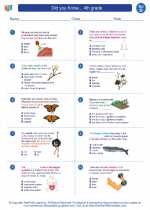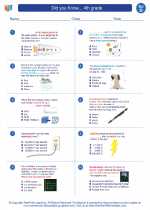Did you Know... 4th grade -> oceanic crust
Oceanic Crust
The oceanic crust is the outermost layer of Earth's lithosphere that is found under the oceans. It is primarily composed of basalt, a type of igneous rock that forms from the solidification of magma. The oceanic crust is thinner and denser than the continental crust, and it plays a crucial role in the process of seafloor spreading and plate tectonics.
Composition of Oceanic Crust
The oceanic crust is made up of several layers, including:
- Basaltic Layer: This layer is composed mainly of basalt, which is formed from the solidification of lava. Basalt is rich in iron and magnesium, giving the oceanic crust its characteristic dark color.
- Gabbroic Layer: Beneath the basaltic layer, there is a layer of gabbro, a coarse-grained rock that forms from the slow cooling of magma beneath the Earth's surface.
Formation of Oceanic Crust
Oceanic crust is formed at mid-ocean ridges through a process called seafloor spreading. Magma rises from the mantle and cools to form new oceanic crust along the spreading center. As new crust forms, older crust is pushed away from the ridge, leading to the formation of a new ocean floor.
Key Concepts to Remember
- Basalt Composition: The oceanic crust is primarily composed of basalt, a dark-colored igneous rock.
- Seafloor Spreading: Oceanic crust is continuously created at mid-ocean ridges through the process of seafloor spreading.
- Plate Tectonics: The movement of oceanic crust plays a key role in the theory of plate tectonics, where it interacts with the continental crust at plate boundaries.
Study Guide Questions
- What is the primary composition of the oceanic crust?
- How is oceanic crust formed?
- What role does oceanic crust play in the theory of plate tectonics?
◂Science Worksheets and Study Guides Fourth Grade. Did you Know... 4th grade
Study Guide Did you Know... 4th grade
Did you Know... 4th grade  Worksheet/Answer key
Worksheet/Answer key Did you Know... 4th grade
Did you Know... 4th grade  Worksheet/Answer key
Worksheet/Answer key Did you Know... 4th grade
Did you Know... 4th grade  Worksheet/Answer key
Worksheet/Answer key Did you Know... 4th grade
Did you Know... 4th grade 

 Worksheet/Answer key
Worksheet/Answer key
 Worksheet/Answer key
Worksheet/Answer key
 Worksheet/Answer key
Worksheet/Answer key

The resources above cover the following skills:
Core Ideas for Knowing Science
Life Science
Organisms are organized on a cellular basis and have a finite life span.